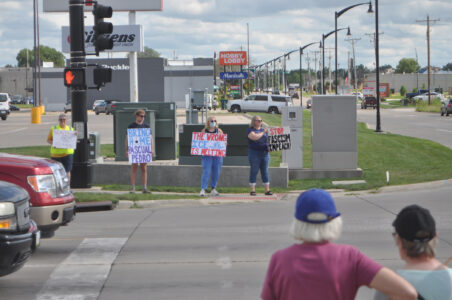What’s the TIF?
Financing to be used for FD housing development
- -Messenger photo by Chad Thompson This duplex along Williams Drive was built in recent years. New homes are to be built near the Fort Dodge Country Club using tax increment financing to give the development a boost.

-Messenger photo by Chad Thompson This duplex along Williams Drive was built in recent years. New homes are to be built near the Fort Dodge Country Club using tax increment financing to give the development a boost.
In 1978 the city of Fort Dodge designated its first area for tax increment financing. TIF is a tool used by municipal governments to advance economic development in a specified area — oftentimes an area that is considered slum or blight.
Since that time, dozens of projects in Fort Dodge and Webster County have been completed that otherwise wouldn’t have, according to Dennis Plautz, CEO of the Greater Fort Dodge Growth Alliance. Plautz was director of planning for the city of Fort Dodge at the time when TIF was first used.
Wells Fargo downtown, Kohl’s, Buffalo Wild Wings, MIDAS and DART facilities and the Iowa Crossroads of Global Innovation, which includes Cargill, Valero and CJ Bio America, each became a reality in large part because of TIF, according to Plautz.
“We use a lot for companies, for example, we have used it significantly in Iowa’s Crossroads of Global Innovation,” Plautz said. “A lot of cleanup in the downtown. Silgan (Containers), back in the ’80s — they wouldn’t be here if not for TIF.”
TIF has undoubtedly been a valuable tool to spur development. But are there projects it should not be used for?
In the case of developing an upscale housing area near the Fort Dodge Country Club, City Councilman Jeffrey Halter thinks it’s a poor use of TIF.
Halter voted no to the project at a recent city council meeting.
The council did end up approving the project, which involves construction of single family houses and twin townhomes in an area surrounded by the country club golf course. The value of those homes after being built will be over $200,000, according to Halter.
Halter said he’s not against the development itself, but doesn’t agree with the use of TIF in financing the project. He has voted for past projects like Buffalo Wild Wings, which used TIF.
“I am not opposed to the country club project,” Halter said. “I think it’s a great project. I just don’t think it’s something we should be using TIF for. It doesn’t clean up slum or blight. It doesn’t create any long-term jobs and doesn’t create an opportunity to collect any extra sales tax.”
And while Plautz declined to express his opinion on the country club project, he said it’s not an unusual use of TIF.
“It’s not uncommon; it’s a normal way to use TIF funds,” Plautz said. “Funds across the state are used similar ways.”
Mayor Matt Bemrich sees the development as a long-term benefit to the community.
“Without the TIF, that project would not be a possibility,” Bemrich said. “It is the future taxes that those who choose to buy and build that will pay off the infrastructure costs. Once that is paid back those houses will go on the tax rolls and be a benefit to the community for decades and decades to come. It would not happen without TIF and that’s how I’ve looked at it. If this project could be a reality without TIF then we probably shouldn’t use TIF. But if you can’t, I think it’s a good use. We’ve done a good job of continually following the law. It may be someone’s opinion that they don’t like how we used it, but it’s not an unusual way to use TIF.”
Councilman Kim Alstott said he supports the use of TIF for the development for the same reason.
“We didn’t have to use TIF for the project,” Alstott said. “Let’s say we didn’t do it, then people will go out to Deer Creek and the city doesn’t get any taxes on it. I think it’s advantageous for the city to help other people out. We don’t use that much in TIF anyways. It’s a lot lower than a lot of other cities. As we looked into housing, they had to have TIF to help them out.”
Alstott added, “We get the money back, so I don’t have a problem with it. It helps out the city bring new tax base and we needed that.”
Halter, instead, believes the city should focus on creating more moderate housing.
“I would be in support of using TIF for housing if it created the housing that the housing study we did said we need,” Halter said. “That’s your moderate, medium income housing ($120,000 to $180,000). That was the type of housing identified in the study that we need in Fort Dodge.
“What the study found is that the people who desire that home want a new home with all the new amenities versus homes that may have been updated or remodeled. They want that newer neighborhood but in the $120,000 price range.”
Halter said the perception is that developers just aren’t interested in building homes in that price range.
“Why not just go TIF for a low to moderate income housing project?” he said. “Other people will tell you no developer wants to build those. I will say we as a city haven’t worked hard enough to find developers and offer incentives to build those kind of houses. It’s a matter of where do we want to put our efforts. I’d rather spend our time and efforts finding low to moderate income housing project incentives.”
Bemrich maintains that building homes at any price level helps the existing market.
“When you build a house, whether it be a $500,000 house or a $100,000 house, it opens a house in the existing market,” Bemrich said. “If it’s someone moving up that opens a house up.”
Bemrich added, “You have to have a full range of housing to impact your marketplace and that’s what we are attempting to do. If you look back, there was very little to almost no new housing development occurring 25 years ago. Nothing in the realm we are currently doing.”
In terms of the country club housing project, the proposal is to create an area nestled within the golf course with lots for 14 single family homes and five twin townhomes.
Kole Petersen, the president of the country club’s board, has said the development wouldn’t be possible without the use of TIF.
The planned housing area consists of 8 acres north of Country Club Drive at the end of a gravel road.
The lots for single family homes will range in size from .33 acres to .53 acres. Those lots will be sold individually, but the five lots for the twin townhomes will be sold to one developer who would build all of them.
Construction could begin next spring.
According to initial estimates, the country club would be paid $827,000 over 11 years.
Another reason Halter is opposed is because it will be 11 years before the TIF is paid off.
“Right now that property is valued at about $150,000, so whatever current property tax the city is getting off that now we will continue to get,” Halter said. “Then when they build these new houses they will be valued a lot higher, but all of that new tax that those houses generate will go back to just paying the TIF.
“The TIF payoff schedule is 11 years, which basically means all the taxes paid on these new houses for 11 years is only being used to pay off the street being built to these houses and infrastructure for these houses (water, utilities, sewer). And then on the 12th year, then the city will begin to collect all of that property tax that we can put into the general fund. Here’s the part that gets me about housing and using TIF, because basically all of the property taxes used from these houses, it will be used to pay street debt.
“That means that for 11 years, almost all of the property tax, none will go to local police, fire, public works, parks and recreation, our library, because those taxes are used for general fund and when you are using TIF, that extra tax money is only paying off the TIF. It’s not paying for more cops, or more firefighters, or parks, or public works to patch more potholes. It’s just going to pay for streets and water and sewer line (to the housing development).”
BREAKING IT DOWN
What is TIF?
Tax increment financing is a method of reallocating property tax revenues, which are produced as a result of an increase in taxable valuation above a “base valuation” figure within a tax increment area. Its authority is in chapter 403 of the code of Iowa.
Tax increment areas are created as a means to maximize property tax dollars within particular areas, in order to pay the cost of public improvement projects (streets, water, sewer, etc.) or to make direct economic development grants or loans to private enterprise as an incentive to locate within the tax increment financing area. The funds must be spent within the urban renewal area and may not be used by cities or counties to supplement their general options.
The base valuation date is the starting point from which incremental value is calculated. For tax increment areas, the base valuation date is Jan. 1 of the calendar year prior to the year in which tax increment debt is first certified to the county auditor.
There are no restrictions on the type of property that can be included in an urban renewal area, but owners of agriculture land must give specific permission before that land may be made part of a city or county urban renewal area.
How are annual tax increment revenues determined?
The amount of incremental valuation is multiplied by the consolidated property tax levy (city, county, school district, area college). The revenues produced from local debt levies must be subtracted because these are returned to each taxing jurisdiction in order to pay outstanding general obligation debt. And these revenues do not become part of the tax increment revenues.
History of TIF
1957: Legislature authorized urban renewal (SF184) — for low income housing and cleanup of slum and blight areas.
1969: TIF was authorized under urban renewal law (HF562).
1985: TIF law was expanded to include allowable economic development purposes.
1995: Urban renewal areas designated as economic development areas are limited to 20 years’ duration, if not also designated as slum or blight. Those urban renewal areas prior to 1995 are not limited in duration.
1999: Legislature required annual reporting about TIF activity annually, including information on each TIF area and its projects.
2003: The 1999 TIF reporting requirements were removed and instead required a semi-annual report on outstanding TIF obligations, to begin in 2003.
2006: HF2777 required more detailed reporting and accounting of TIF revenue and expenditure to be included in the annual budget process, replacing 1999 and 2003 reporting requirements.
2012: HF2460 replaced the 2006 requirement with a more detailed reporting process due Dec. 1 of each year. Cities and counties must submit a compliant report to the state prior to annual budget certification.
Did you know?
• There are over 3,000 TIF districts in the state of Iowa.
• Not every TIF district expires. But any TIF area created after 1995 has an expiration date on it.
*Courtesy of Dennis Plautz and the Greater Fort Dodge Growth Alliance





